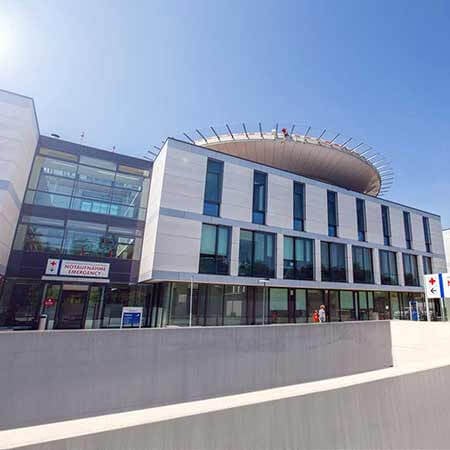Angiomas of brain are vascular neoplasms that usually do not cause any symptoms but can become a source of bleeding. In some patients, they can provoke epileptic seizures, headaches, paresis, and paralysis and can also block the cerebrospinal fluid outflow, causing hydrocephalus. Treatment of angioma of brain is required in cases where there is a threat that a hemorrhage will appear or the disease causes some symptoms. You can travel abroad to receive medical care. You are welcome to use the Booking Health service to find prices and choose a hospital.
Content
- Treatment principles
- Surgical treatment
- Embolization
- Radiosurgery
- Where to undergo your angioma treatment?
Treatment principles
Patients with an established diagnosis are not always immediately referred for surgical treatment. Many angiomas do not cause any symptoms, do not manifest any growth, and often shrink or even disappear. Neoplasms up to 1 cm in size usually do not cause any problems, and they are only monitored. Larger angiomas may cause some symptoms, and the lifetime risk of a brain hemorrhage is 15%.
Indications for treatment are as follows:
- epileptic seizures that cannot be controlled with medications;
- anamnesis with a subarachnoid hemorrhage;
- development of symptoms or complications.
The following three treatment options can be used:
- surgical interventions;
- endovascular procedures performed from inside the blood vessels;
- radiosurgery (irradiation).
A surgical treatment method is considered the main one. If an angioma is located too deep or the operation is contraindicated for a person, radiosurgery is used. Endovascular angioma embolization as a stand-alone procedure is less effective but can be used in addition to other treatments. For example, a combination of endovascular and radiosurgical treatment helps to destroy the angioma and reduces the risk of a hemorrhage.
Surgical treatment
The treatment of angioma of brain is usually surgical. Doctors perform osteoplastic trepanation of the skull and completely remove a vascular neoplasm. When performed correctly, the operation is quite safe since the angioma itself does not contain any brain tissue. The tumor removal does not lead to a neurological deficit.
The easiest task for doctors is to remove the neoplasms located superficially. However, with deep localization, the treatment of angioma of brain becomes more risky. In this case, doctors must perform an encephalotomy, a surgical procedure to dissect the brain tissue to get to the vascular tumor and remove it. Doctors in countries offering advanced medical care use neuronavigation and preoperative and intraoperative functional diagnostics to identify important areas of the brain and bypass them, thereby laying the safest route to the angioma.
Embolization
Embolization is usually performed not as a stand-alone medical procedure but as a stage in the combination treatment of angioma of brain. The procedure can be combined with surgery or radiation therapy. An endovascular procedure can be used as the main method of treatment of angioma of brain if the neoplasm is small and a patient has contraindications to other treatment options.
The procedure is performed from inside the blood vessels. It is not required to open the cranial cavity, which makes the technique more sparing compared to the operation.
The essence of the technique is that the angioma is not physically removed from the brain, but the blood flow through it stops or significantly decreases. This leads to a low probability of its rupture. Doctors deliver spirals to the brain neoplasm and insert them into the cavities through the blood vessels in the leg. Spirals initiate the formation of blood clots. These clots fill the angioma, blocking blood flow.
The advantages of embolization are that the technique is minimally traumatic, safe, and does not require any rehabilitation. But this is not the most reliable method of treatment of angioma of brain. The blood flow through the angioma does not always stop completely, and if it is stopped, it can resume over time.
Radiosurgery
Radiation therapy is usually used in oncology treatment. However, the operation can be performed not only to destroy the tumor. The treatment of angioma of brain abroad is carried out using Gamma Knife and CyberKnife procedures. They allow doctors to destroy these neoplasms in a single procedure with a precisely directed dose of radiation and with a minimal risk of post-radiation complications.
Radiosurgery is used for the treatment of angioma of brain that is deep and too risky to remove using surgical techniques. This is a good treatment option for those patients for whom surgery is contraindicated due to concomitant diseases.
The main benefits of radiosurgery are as follows:
- absence of invasion;
- treatment without any discomfort;
- even if the angioma is in a deep location, there is a low risk of complications;
- no need for rehabilitation.
But the technique also has disadvantages. This is effective for a small angioma growth, optimally up to 3 cubic centimeters. Larger neoplasms increase the risk of a hemorrhage. Radiosurgery eliminates the symptoms not instantly, but gradually, since the neoplasm decreases in size over several months after irradiation. In some patients, symptoms do not completely regress. But in any case, they are relieved, for example, the frequency of epileptic seizures decreases, which improves the patient's quality of life.
Angiomas in the brainstem areas can be safely irradiated with radiosurgery. However, doctors have to use smaller doses of radiation to avoid hemorrhages.
Where to undergo your angioma treatment?
You can be examined for a diagnosis and receive top-class medical care in one of the foreign hospitals. If you opt to undergo your treatment in developed countries, you will receive quality medical care. Treatment abroad will be more effective, safer and more reliable.
The main advantages of angioma treatment abroad are as follows:
- High-precision diagnostics using state-of-the-art equipment, which helps to establish an accurate diagnosis, distinguish angioma from other diseases and choose the best treatment tactics.
- Hospitals in developed countries have the necessary equipment for safe neurosurgical operations such as neuronavigation systems, intraoperative ultrasound or other methods of imaging diagnostics, and intraoperative functional diagnostics can be used whenever required, powerful operating microscopes are used as well.
- You will be treated by reputable specialists from foreign hospitals, who are the best in their areas of medicine.
- Healthcare professionals abroad use modern variants of radiosurgery. They direct radiation at the angioma more precisely to avoid irradiating healthy tissue. The treatment appears more comfortable because a frameless stereotactic system is used. This means that physicians do not need to fix the stereotactic frame rigidly with screws to the patient's periosteum.
You can find the cost of treatment on the Booking Health website. You are welcome to use our service to compare the cost of treatment in different hospitals and make your appointment at the medical facility at the best price. Please leave your request on the Booking Health website and our specialists will review it and contact you on the same day. We will help you to choose the most suitable hospital and organize your trip. When making your treatment appointment through the Booking Health service, the cost of treatment will be lower due to the absence of additional fees for foreign patients.
Authors:
This article was edited by medical experts, board-certified doctors Dr. Nadezhda Ivanisova, and Dr. Bohdan Mykhalniuk. For the treatment of the conditions referred to in the article, you must consult a doctor; the information in the article is not intended for self-medication!
Our editorial policy, which details our commitment to accuracy and transparency, is available here. Click this link to review our policies.
Sources:
MedicineNet
Web MD
The Lancet














